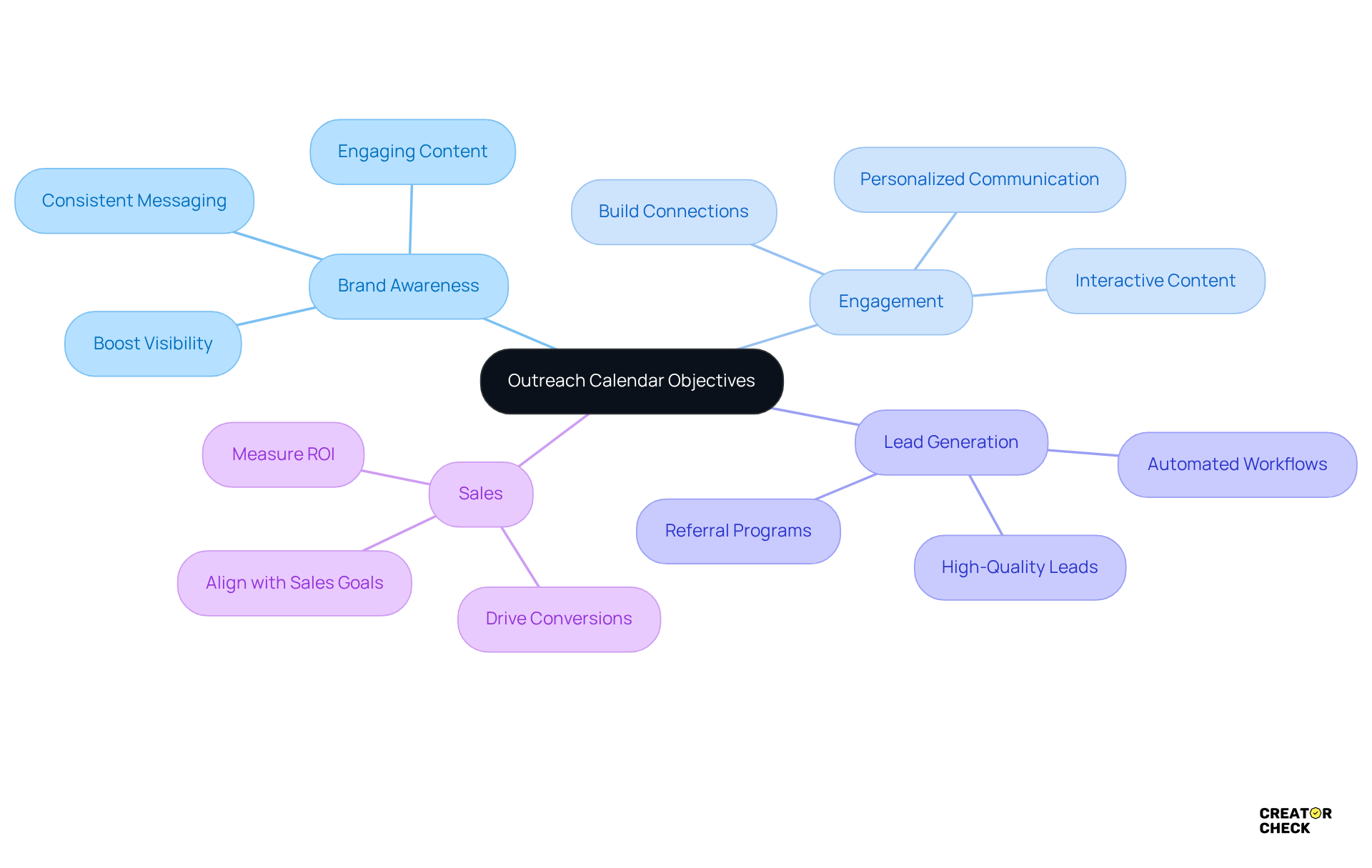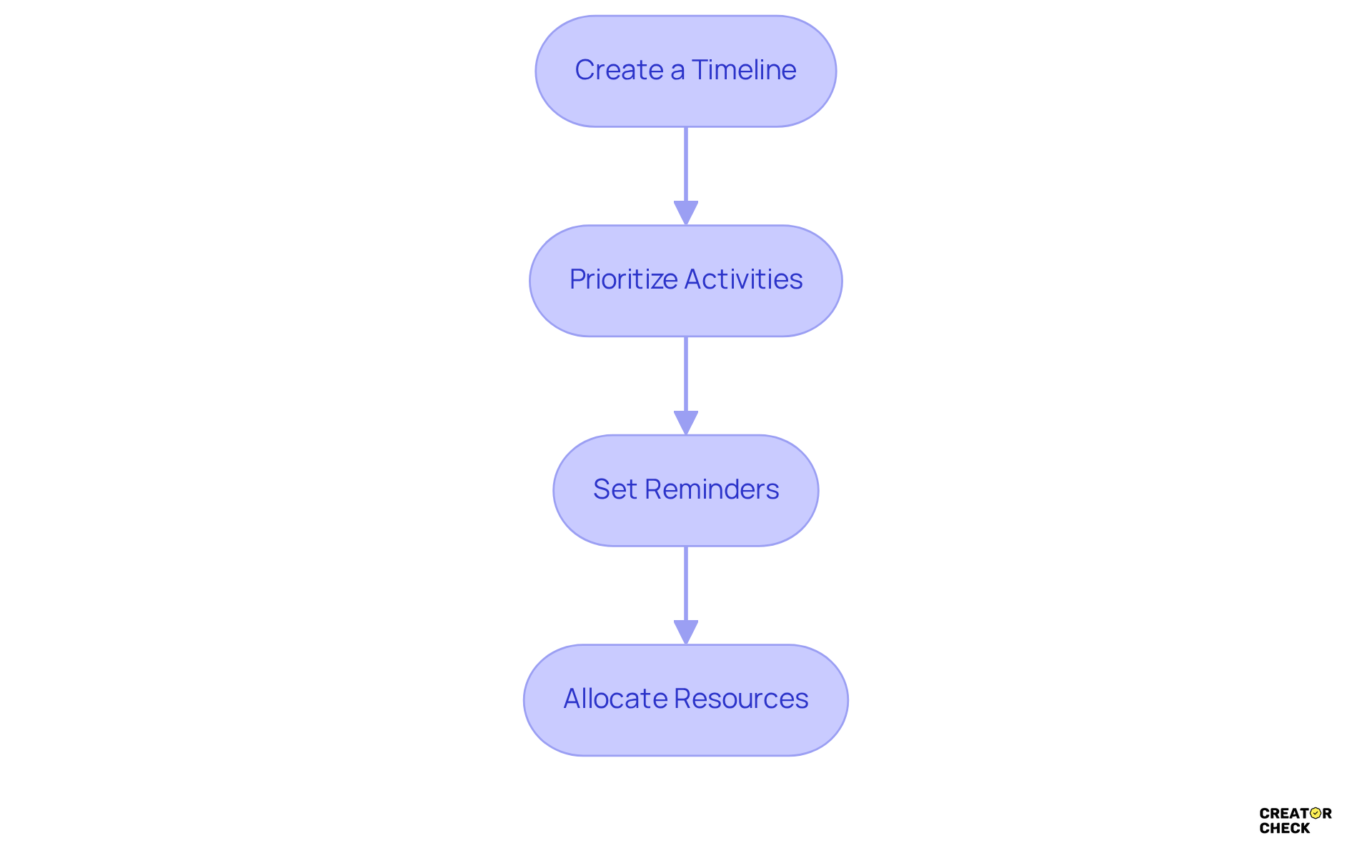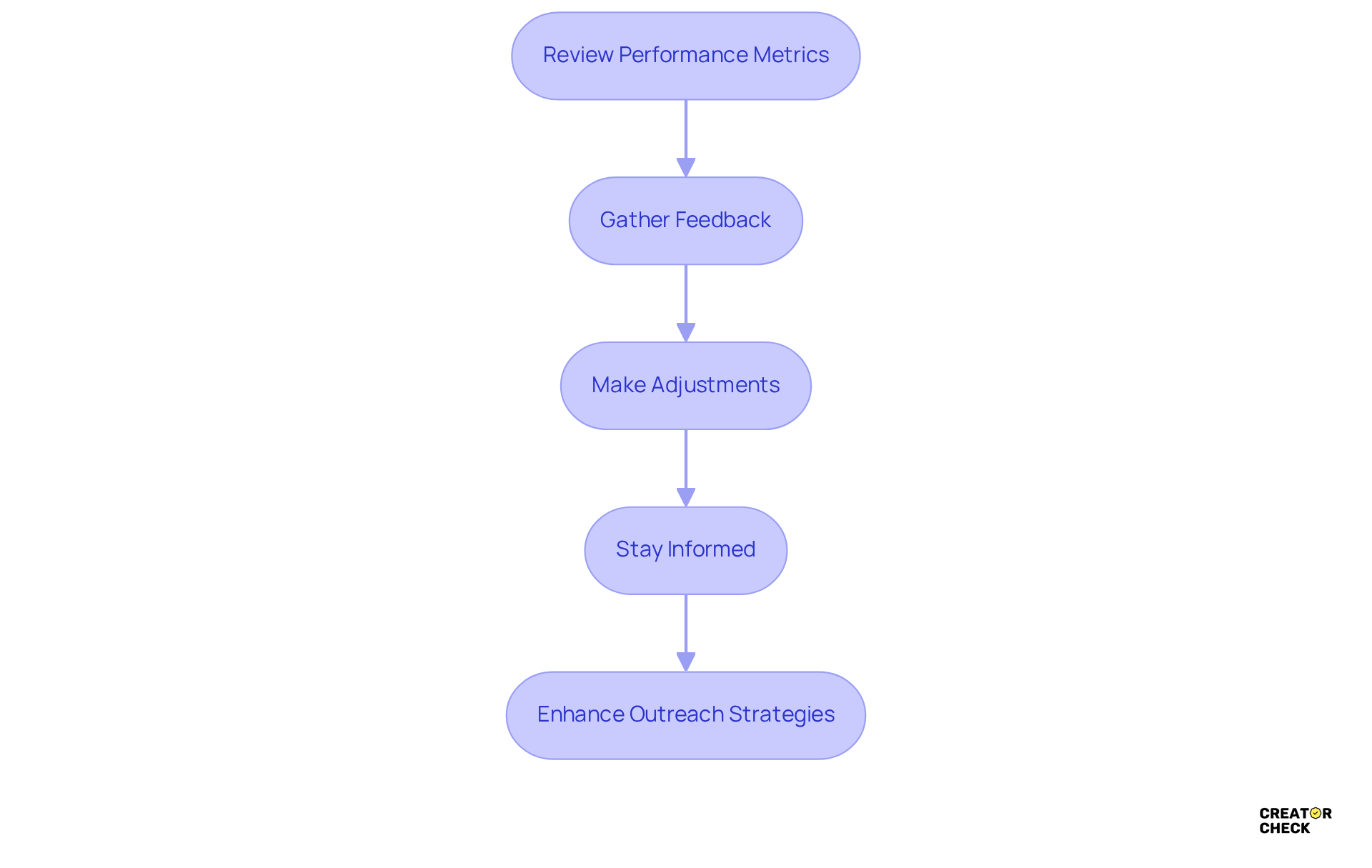Overview
Creating an outreach calendar that aligns with your brand plans is all about:
- Setting clear objectives
- Pinpointing key components
- Choosing the right tools
- Scheduling your activities
- Keeping an eye on performance
So, why does this matter? Well, a structured approach not only boosts engagement but also helps build long-lasting relationships. By aligning your outreach efforts with specific goals, target audiences, and key metrics, you’re setting yourself up for success. This ultimately leads to better brand awareness and more effective lead generation. Isn’t that what we all want?
Introduction
Creating a successful outreach calendar is key for brands looking to boost their engagement strategies and build lasting connections. By syncing outreach efforts with brand goals, businesses can map out a plan that not only enhances visibility but also fosters meaningful interactions with their target audience.
But here’s the catch: it can be tricky to juggle all the pieces—from setting clear goals to picking the right tools and effectively scheduling activities.
So, how can brands make sure their outreach calendar isn’t just a static plan, but a flexible tool that evolves with their needs and maximizes impact?
Define Your Outreach Calendar Objectives
To kick things off, think about what you want to achieve with your engagement calendar. Here are some things to consider:
- Brand Awareness: Are you hoping to boost visibility for a new product or service? Effective engagement can really amp up brand recognition, especially when you're launching in new markets.
- Engagement: Do you want to build deeper connections with your audience or influencers? Engaging content and personalized communication can create loyalty and trust.
- Lead Generation: Is your aim to attract potential clients or partners? With 37.1% of marketers pointing to high-quality lead generation as their biggest challenge, a focused approach can lead to better outcomes.
- Sales: Are you looking to drive conversions or sales through your engagement activities? Aligning your engagement with sales goals can boost conversion rates and overall revenue.
Once you’ve nailed down your objectives, jot them down and make sure they’re Specific, Measurable, Achievable, Relevant, and Time-bound (SMART). This clarity will steer your planning and execution. As Shameer Sachdev points out, having clear objectives is crucial for maximizing the impact of your engagement efforts. Plus, using tools like Creator Check can streamline your engagement processes, helping you reach those goals more efficiently. So, what does this mean for you?

Identify Essential Components of Your Outreach Calendar
An effective outreach calendar should include several key components to ensure you successfully engage with your target audience:
-
Target Audience: First things first, let’s define who you’re reaching out to. Identifying key demographics and interests is crucial. Understanding your audience can really make a difference—tailored communication can boost engagement levels significantly. Did you know that research shows tailored messaging can lead to a 90% increase in response rates compared to generic approaches? Plus, utilizing Creator Check's features, like its AI-powered inbox, can make managing these communications a breeze, ensuring your engagement is both efficient and effective.
-
Content Types: Next up, what types of content will you be using? Think about emails, social media posts, blog articles, and press releases. Mixing owned and earned media can really enhance your communication effectiveness since these channels tend to be more cost-effective and help build trust with your audience.
-
Key Dates: Don’t forget to mark those important dates on your calendar—product launches, events, or seasonal campaigns. Aligning your communication with these key moments can really maximize visibility and engagement, making sure your messages hit home when your audience is most receptive.
-
Channels: Now, let’s talk about the platforms you’ll use for communication. Whether it’s email, social media, or direct messaging, each channel has its strengths. For example, cold emailing can reach a broader audience, while LinkedIn engagement allows for more personalized connections.
-
Metrics for Success: Finally, how will you measure the effectiveness of your engagement efforts? Key performance indicators (KPIs) like engagement rates, open rates, and conversion rates are essential for assessing the impact of your campaigns. Regularly evaluating these metrics will help you enhance your strategies and boost future engagement initiatives. And don’t forget, Creator Check's automated payment processing can simplify the financial aspects of your initiatives, letting you focus on building those connections.
By building an outreach calendar around brand plans, you’re setting yourself up for a structured approach that not only enhances your engagement but also fosters long-term relationships with influencers and media contacts. So, what does this mean for you? It’s all about creating a roadmap that guides your engagement efforts and makes the process enjoyable!

Choose Tools for Managing Your Outreach Calendar
Are you considering building an outreach calendar around brand plans? Here are some handy tools you might want to consider:
- Project Management Software: Tools like Asana or Trello can help you keep tasks and deadlines organized. They make it easier to see what’s on your plate!
- Calendar Apps: Google Calendar or Outlook are great tools for building outreach calendar around brand plans and setting those all-important reminders. Don’t let anything slip through the cracks!
- Email Marketing Platforms: Services like Mailchimp or Sendinblue can assist you in managing your email campaigns and tracking how well they’re doing. It’s all about keeping your audience engaged!
- Analytics Tools: Use Google Analytics or social media insights to measure the success of your engagement efforts. Knowing what works is key!
So, when choosing tools, look for ones that play nicely together. This way, you can create a seamless workflow that makes your life a whole lot easier!

Schedule Outreach Activities and Set Timelines
To effectively schedule your outreach activities, let’s consider a few simple steps:
-
Create a Timeline: Grab your calendar tool and start mapping out when each outreach activity will happen. Keep an eye on key dates like holidays, industry events, and product launches—these can really impact your engagement rates. Did you know that prompt engagement can lead to a 10-20% rise in qualified visits? That just shows how important strategic timing is!
-
Prioritize Activities: Take a moment to evaluate which engagement initiatives are most crucial. By prioritizing, you ensure that your most significant activities get the spotlight they deserve. Marketing strategists often emphasize the need for targeted engagement efforts. For instance, connecting with micro-influencers can lead to better engagement because of their loyal followings.
-
Set Reminders: Don’t forget to implement reminders to keep your engagement schedule on track! Regular prompts can help you maintain momentum and make sure that no critical activities slip through the cracks.
-
Allocate Resources: It’s important to clearly define who’s responsible for each engagement activity and make sure they have the resources they need to execute effectively. This not only streamlines the process but also enhances accountability within your team, fostering clear communication and collaboration.
By building an outreach calendar around brand plans that includes these elements, influencer agencies can really boost their interaction strategies and drive more successful campaigns. So, are you ready to take your outreach activities to the next level?

Evaluate and Adjust Your Outreach Calendar Regularly
To keep your outreach calendar effective, let’s chat about some strategies you might find useful:
-
Review Performance Metrics: Take a moment to regularly check how your outreach activities are performing. Key metrics like open rates, response rates, and conversion rates are your best friends here. They help you grasp the impact of your efforts and guide your next steps.
-
Gather Feedback: Don’t shy away from collecting feedback from your team and stakeholders about your engagement strategies. You can do this through surveys, team meetings, or even one-on-one chats. This way, you’ll get a well-rounded view of what’s working and what could use a little TLC. As industry experts often say, feedback is key to refining your messaging and boosting personalization.
-
Make Adjustments: Be ready to tweak your engagement calendar while building an outreach calendar around brand plans based on the performance data and feedback you gather. This could mean shifting timelines, changing up your content types, or even targeting different audience segments to maximize engagement. Regular adjustments keep your strategies fresh and effective, fostering a culture of continuous improvement.
-
Stay Informed: Keep an eye on industry trends and changes that might affect your engagement strategy. Staying updated is crucial for maintaining a competitive edge and ensuring your efforts resonate with your target audience. Plus, don’t forget about compliance with legal requirements like GDPR to uphold your reputation and deliverability.
By putting these practices into action, influencer agencies can really amp up their outreach strategies, leading to better engagement and higher conversion rates. So, what do you think? Ready to enhance your outreach game?

Conclusion
Building an outreach calendar that aligns with your brand plans is a smart move that can really boost engagement and help you build lasting relationships. By clearly defining your objectives, identifying the key components, picking the right tools, scheduling activities effectively, and regularly checking in on performance, you can create a roadmap that not only guides your outreach efforts but also maximizes your impact.
So, what are the key takeaways from this guide? First off, setting SMART goals is crucial. Understanding your target audience is just as important, along with utilizing different types of content and channels. Don’t forget to incorporate essential tools like project management software and analytics platforms to streamline the process, making your outreach activities more efficient and effective. Plus, regularly evaluating and adjusting your outreach calendar based on performance metrics and feedback will help keep your strategies relevant and impactful.
Ultimately, the importance of having an outreach calendar in your brand strategy can't be overstated. It’s a vital tool for navigating the complexities of audience engagement and hitting your business objectives. By prioritizing your outreach efforts and staying adaptable to changes, you can boost your visibility, build trust, and drive conversions. Embracing these practices will not only elevate your outreach strategies but also contribute to sustained growth and success in an ever-changing market. So, let's get started on making your outreach calendar work for you!
Frequently Asked Questions
What should I consider when defining my outreach calendar objectives?
When defining your outreach calendar objectives, consider goals such as brand awareness, engagement with your audience or influencers, lead generation, and sales. Ensure your objectives are Specific, Measurable, Achievable, Relevant, and Time-bound (SMART) to maximize the impact of your engagement efforts.
How can I identify my target audience for the outreach calendar?
To identify your target audience, define key demographics and interests. Tailored communication based on this understanding can significantly boost engagement levels, as research shows that personalized messaging can lead to a 90% increase in response rates compared to generic approaches.
What types of content should I include in my outreach calendar?
Your outreach calendar should include various content types such as emails, social media posts, blog articles, and press releases. Mixing owned and earned media can enhance communication effectiveness and build trust with your audience.
Why is it important to mark key dates on my outreach calendar?
Marking key dates, such as product launches, events, or seasonal campaigns, is important because aligning your communication with these moments can maximize visibility and engagement, ensuring your messages resonate with your audience when they are most receptive.
What channels can I use for communication in my outreach calendar?
You can use various channels for communication, including email, social media, and direct messaging. Each channel has its strengths; for instance, cold emailing can reach a broader audience, while LinkedIn allows for more personalized connections.
How can I measure the success of my outreach efforts?
To measure the success of your outreach efforts, track key performance indicators (KPIs) such as engagement rates, open rates, and conversion rates. Regularly evaluating these metrics will help you enhance your strategies and improve future engagement initiatives.




